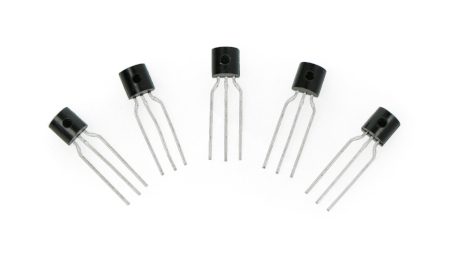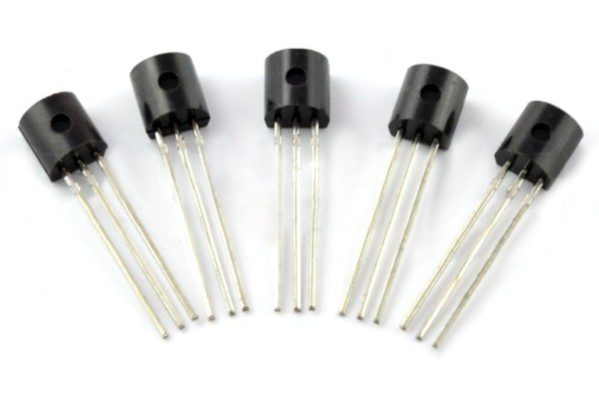Table of Contents:
2N2222 is the most widely used NPN bipolar junction transistor.
It can be used for switching applications and amplifying analog signals.
It is a transistor with NPN conduction type.
Compared to other similar small transistors, one of its unique advantages is its ability to handle high currents.
Typically, it can switch a load current of 800mA, which is really high compared to other similar transistors.
When performing amplification applications, it receives an analog signal through its collectors, and another signal is applied to its base.
The analog signal can be a voice signal with an analog frequency of almost 4kHz (human voice bandwidth.
NPN transistor 2N2222 - master of fast switching
NPN transistors, such as the 2N2222, are commonly used in VHF (very high frequency) amplifiers and switching applications. The transistor is made of silicon material.
This type of transistor is considered a normal transistor and is used in the same way as an NPN transistor. Base, emitter and collector are the three terminals of this transistor.
The 2N2222 transistor provides a constant collector current of up to 800mA, making it ideal for low and medium current applications.
It has a delay time of just 10ns, a hold time of 225ms, a sink time of 60ms and a rise time of 25ms to operate at a high transition frequency of 250 MHz.
Transistor 2N2222A vs transistor BC547
The 2N2222A transistor is very similar to the widely used BC547 NPN transistor.
However, there are two major differences between the two.
Compared to the BC547, the 2N2222 has a collector current of up to 800 mA and a power loss of 652 mW, allowing it to handle larger loads.
It can be used for the same applications as the BC547 transistor, such as switching and amplification.
In a switching application, it functions in two areas: saturation and cutoff.
In the saturation area, a full current flows from the emitter to the collector with a current range of 110 to 800 mA, and it acts as a switch.
As a result, the user can only connect loads up to 800 mA.
Similarly, when no current flows from the emitter to the collector in the cutoff area, it behaves like a switch that is turned off.
Active state
In this mode, the transistor is usually used as a current amplifier.
In active mode, the two junctions are polarized in different ways, with the emitter-base junction polarized in the conduction direction and the collector-base junction polarized in the negative direction.
In this mode, a current flows between the emitter and collector, the magnitude of which is proportional to the base current.
Cut-off condition
In this mode, the collector-base junction and the emitter-base junction are negatively polarized.
There is no current flow, except for small leakage currents, because both PN junctions are polarized in the negative (usually on the order of a few nanoamperes or picoamperes).
In this mode, the BJT is off and the circuit is an open circuit.
Switching and digital logic circuits are mainly used in the cutoff region.
Saturation state
The base-emitter and base-collector junctions are polarized in the conduction direction in this area.
With almost zero resistance, current flows freely from the collector to the emitter.
In this mode, the transistor is fully on and the circuit is closed.
The saturation region is also used mainly in switching circuits and digital logic circuits.
Practical applications of the 2N2222 transistor
Compared to the ordinary NPN transistor BC547, the 2N2222 is very similar, but the 2N2222 allows a collector current of 800mA, as well as a power dissipation of 652mW, which can be used to drive larger loads compared to the BC547.
The 2N2222 is used for PWM modulation due to the short propagation times mentioned earlier.
Based on this transistor, it is possible to build preamplifier stages in audio amplifiers, radio communication circuits as well as wide-ranging automation and robotics devices based on microcontrollers.
Transistor 2N2222 as an electronic switch
One of the most common applications of transistors in an electronic circuit is simple switches.
In other words, when a voltage is supplied to the base, the transistor conducts current through the collector-emitter.
The switch is turned off when there is no base voltage.
The switching action of the transistor is based on the voltage applied to the base terminal.
The collector-emitter voltage is almost 0 when sufficient voltage is applied between the base and emitter (VIN > 0.7 V).
As a result, the transistor acts as a short circuit.
When no or zero voltage is applied to the input, the transistor operates in the cutoff region and acts as an open circuit.
In this type of switching connection, the load (in this case, an LED) is connected to the switching output via a reference point.
When the transistor is turned on, current flows from the source to ground through the load. The 2N2222 transistor can also serve as a switch in a circuit with two resistors, where the input resistor limits the transistor’s base current and the second resistor controls the LED in the collector line.
The transistor begins to operate when the switch is closed, and the intervals at which the LED is turned on and off are controlled by the value of the resistance.
Transistor as signal amplitude amplifier
An amplifier circuit can be defined as a circuit used to increase the amplitude of a signal.
The input of an amplifier is a voltage or current, and the output is an amplified input signal.
A transistor can receive a weak signal through the base junction and release the amplified signal through the collector.
Transistors are commonly used in RF (radio frequency), OFC (optical fiber communication), audio amplification and other applications.
We usually use a common emitter configuration to make the transistor act as an amplifier.
How useful was this post?
Click on a star to rate it!
Average rating 5 / 5. Vote count: 2
No votes so far! Be the first to rate this post.





















